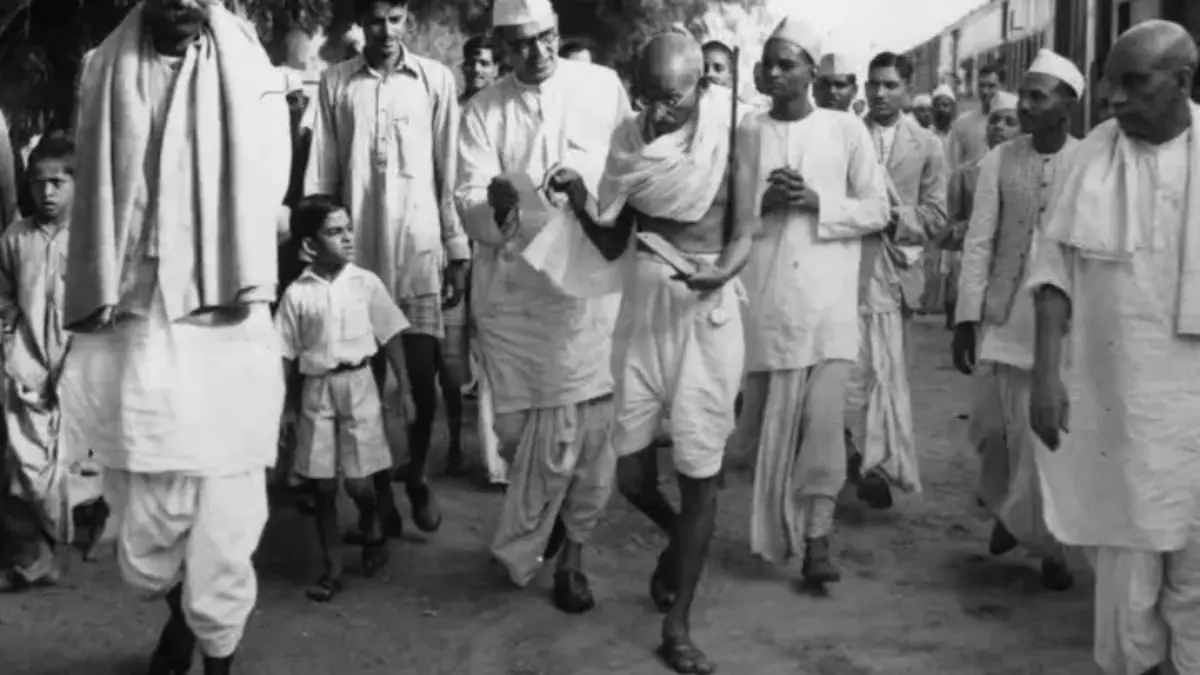Champaran Satyagraha: Gandhi's First Successful Movement in India
History Indian HistoryPosted by NewAdmin on 2025-02-04 08:51:35 |
Share: Facebook | Twitter | Whatsapp | Linkedin Visits: 14

Champaran Satyagraha was a significant movement led by Mahatma Gandhi in 1917 in the Champaran district of Bihar. This was Gandhi's first major involvement in Indian politics and a critical step in the development of his philosophy of nonviolent resistance, or Satyagraha. The movement was sparked by the plight of indigo farmers who were being exploited by British planters. The farmers were forced to grow indigo on a portion of their land under the tinkathia system, which required them to dedicate a third of their land to indigo cultivation, often under unfavorable terms. The planters paid them low prices for their crops and imposed harsh conditions, leading to widespread poverty and suffering.
Gandhi arrived in Champaran after being requested by local leaders and activists, who were seeking justice for the oppressed farmers. Initially, the British authorities tried to prevent him from entering the region, but Gandhi’s persistence, along with his reputation as a leader of nonviolent protest, allowed him to stay and investigate the situation. He began by talking to the farmers and collecting evidence of their exploitation. Gandhi organized peaceful protests and nonviolent civil disobedience, encouraging the farmers to stand up for their rights.
The movement gained widespread support from various sections of society, and the involvement of the local population played a crucial role in its success. Gandhi’s efforts were focused not only on addressing the immediate grievances of the farmers but also on promoting a sense of unity and self-reliance among the people. His leadership led to a major victory when the British authorities were forced to appoint an inquiry commission, which ultimately ruled in favor of the farmers. The planters had to refund a portion of the money to the farmers, and the tinkathia system was abolished.
The Champaran Satyagraha was important because it marked the first successful application of Gandhi’s principles of nonviolent resistance on a large scale. It also laid the foundation for his future campaigns in India and demonstrated the potential of nonviolent methods in challenging British colonial rule. The movement not only helped improve the lives of the farmers but also set the stage for broader participation in the national freedom struggle.
Search
Categories
- Sports
- Business
- History
- Politics
- International
- Science & Technology
- Social Issues
- Disaster Management
- Current Affairs
- Education
- Startup Business
- Startup News
- Awards
- Community Services
- Fundraising Events
- Volunteer Services
- Health Initiatives
- Innovations and Initiatives
- In News
- dummybanners
- Awards
- Partners
- Products
- Press Releases
- News
- Fast Check
- South
- సినిమా
- Gallery
- Sunday Chronicle
- Hyderabad Chronicle
- లైఫ్ స్టైల్
- National
- క్రైం
- ట్రెండింగ్
- జాబ్స్
- అంతర్జాతీయo
- బిజినెస్
- రాజకీయం
- బిజినెస్
- సంపాదకీయం
- నవ్య
- చిత్ర జ్యోతి
- క్రీడలు
- జాతీయం
- తెలంగాణ
- తాజా వార్తలు
- మన పార్టీ
- మన నాయకత్వం
- మన విజయాలు
- డౌన్లోడ్స్
- మీడియా వనరులు
- కార్యకర్తలు
- North East Skill Center News
- Government Schemes
- Entrepreneurship Support
- Employment Opportunities
- Skill Training Programs
- Departments
- Investments
- Initiatives
- Resources
- Telangana IT Parks
- Events & Jobs
- Press Releases
- News
- Airport News
- Newtons Laws of Motion
- Karbonn in Business
- Investments in Karbonn
- Company quarterly sales
- Markets
- Auto News
- Industry
- Money
- Advertisements
- Stock target
- Company Updates
- Stock Market
- Company Sales
- Staffing and HR
- Constituency Assembly
- General News
- Srikalahasti Temple
- Bojjala Sudhir Reddy
- Technology & Innovation
- Sports
- Business
- Products
- Industries
- Services & Trainings
- Tools & Resources
- Technology Integration
- Drug Seizures & Arrests
- Telangana Narcotics
- Law & Enforcement
- Rehabilitation
- Nationwide Drug Policing
- Nigeria Seizures
- Global Operations
- Drug Awareness
- Drug Enforcement Tech
- NCB Drug Seizures
- Judicial Crackdown
- India's Surveillance Tools
- Cross-Border Links
- Women Safety
- Cyber Crimes
- Drug Abuse
- Traffic & Road Safety
- Community Connect
- Public Safety Alerts
- Citizen Assistance
- Nellore City News
- Politics & Administration
- Events & Festivals
- Agriculture & Rural
- Business & Economy
- Health & Wellness
Recent News
- BJP takes majority control in Mumbai's bus cooperative election
- Cyber Vigilante Exposes Alleged Tech Scam, Captures Scammer's Reaction on Webcam
- Denmark to Tax Books Zero Percent to Tackle 'Reading Crisis'
- 'Uncertainty in external demand remains major drag on growth': Malhotra
- Ex-Palestinian Basketball Player Mohammed Shaalan Killed By Israeli Strike
- Vice-President Dhankhar Feared for Speaking Truth to Power
- Floods Claim Hundreds of Pakistani Lives
- MSME meltdown looming as global uncertainty persists